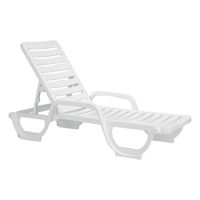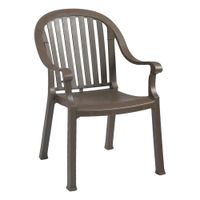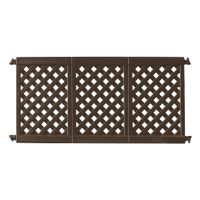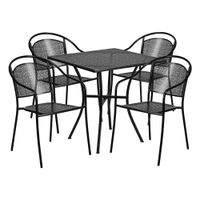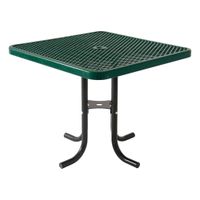Call +(254) 703 030 000 / 751 483 999 / 721 704 777
- Home
- Furnishings Appliances Hospitality
- Outdoor Furniture
- Patio Furniture
Frequently Asked Questions
What materials are best for durable outdoor patio furniture?
The best materials for durable outdoor patio furniture include:
1. **Teak Wood**: Known for its natural oils and tight grain, teak is highly resistant to water, insects, and decay. It weathers beautifully to a silver-gray patina and requires minimal maintenance.
2. **Eucalyptus**: A more affordable alternative to teak, eucalyptus is also resistant to moisture and insects. It requires regular oiling to maintain its color and durability.
3. **Cedar**: Naturally resistant to rot and insects, cedar is lightweight and has a pleasant aroma. It requires sealing or staining to maintain its appearance and longevity.
4. **Aluminum**: Lightweight and rust-resistant, aluminum is ideal for outdoor use. It is often powder-coated for added protection and comes in various styles and colors.
5. **Wrought Iron**: Known for its strength and classic look, wrought iron is highly durable. It requires regular maintenance to prevent rust, including painting and sealing.
6. **Steel**: Heavier than aluminum, steel is strong and durable. Galvanized or stainless steel options are rust-resistant, but they may require occasional maintenance.
7. **Resin Wicker**: Made from synthetic materials like polyethylene, resin wicker is weather-resistant and mimics the look of natural wicker. It is lightweight, easy to clean, and available in various colors.
8. **High-Density Polyethylene (HDPE) Plastic**: This eco-friendly material is resistant to moisture, fading, and cracking. It is low-maintenance and available in a wide range of colors and styles.
9. **Concrete**: Extremely durable and weather-resistant, concrete furniture is heavy and stable. It can be molded into various shapes and finishes but may require sealing to prevent staining.
10. **Polypropylene**: A type of plastic that is UV-resistant and durable, polypropylene is lightweight and easy to clean, making it suitable for outdoor use.
These materials offer a combination of durability, weather resistance, and aesthetic appeal, making them ideal for outdoor patio furniture.
How do I maintain and clean patio furniture?
To maintain and clean patio furniture, follow these steps:
1. **Regular Dusting and Brushing**: Use a soft cloth or brush to remove dust and debris from surfaces. This prevents dirt buildup and reduces wear.
2. **Material-Specific Cleaning**:
- **Wood**: Use a mild soap solution and a soft brush. Rinse with water and let it dry completely. Apply a protective sealant annually.
- **Metal**: Clean with soapy water and a soft cloth. Rinse and dry thoroughly to prevent rust. Apply a rust-resistant finish if needed.
- **Plastic**: Use a mixture of water and mild detergent. Scrub with a soft brush, rinse, and dry. Avoid abrasive cleaners that can scratch.
- **Wicker**: Vacuum to remove dust. Clean with a mild soap solution and a soft brush. Rinse and dry in the sun.
- **Fabric**: Remove cushions and wash covers according to manufacturer instructions. Spot clean with mild soap and water. Allow to air dry.
3. **Stain Removal**: For tough stains, use a mixture of vinegar and water or a specialized cleaner. Test on a small area first.
4. **Mold and Mildew**: Mix one cup of bleach with a gallon of water. Apply with a brush, rinse thoroughly, and dry.
5. **Protective Measures**: Use furniture covers when not in use. Store cushions indoors during harsh weather. Apply UV protectant sprays to prevent fading.
6. **Seasonal Maintenance**: Inspect for damage and repair as needed. Tighten screws and bolts. Reapply protective coatings before winter.
7. **Storage**: Store furniture in a dry, sheltered area during off-seasons to prolong its life.
Regular maintenance and cleaning will keep your patio furniture looking new and extend its lifespan.
What are the most popular styles of patio furniture?
The most popular styles of patio furniture include:
1. **Modern/Contemporary**: Characterized by sleek lines, minimalistic design, and the use of materials like metal, glass, and synthetic fibers. This style often features neutral colors and a focus on functionality.
2. **Traditional**: Often made from wood or wrought iron, traditional patio furniture includes classic designs with ornate details. It typically features rich colors and plush cushions, offering a timeless and elegant look.
3. **Rustic**: Emphasizing natural materials like wood and stone, rustic patio furniture has a rugged, earthy appeal. It often includes handcrafted elements and a focus on comfort and durability.
4. **Coastal**: Inspired by beachside living, coastal patio furniture uses light, airy colors and materials like wicker, rattan, and teak. It often includes nautical elements and is designed to withstand salty air and moisture.
5. **Industrial**: Featuring raw materials like metal and reclaimed wood, industrial patio furniture has a utilitarian and edgy look. It often includes exposed hardware and a mix of textures.
6. **Bohemian**: Known for its eclectic and vibrant style, bohemian patio furniture incorporates colorful textiles, patterns, and a mix of materials. It often includes hammocks, poufs, and layered rugs for a relaxed vibe.
7. **Mid-Century Modern**: This style features clean lines, organic shapes, and a mix of materials like wood and metal. It often includes retro-inspired designs and bold colors.
8. **Farmhouse**: Combining rustic charm with modern comfort, farmhouse patio furniture often uses distressed wood and metal. It features simple, functional designs with a cozy, inviting feel.
These styles cater to various tastes and preferences, allowing homeowners to create outdoor spaces that reflect their personal style and complement their home's architecture.
How do I choose the right size patio furniture for my space?
To choose the right size patio furniture for your space, start by measuring the dimensions of your patio. Consider the shape and layout, noting any architectural features or obstacles. Determine the primary function of the space, such as dining, lounging, or entertaining, to guide your furniture selection.
Create a scaled floor plan or use online design tools to visualize different arrangements. Leave enough room for movement, ensuring pathways are at least 3 feet wide. For dining areas, allow 2-3 feet of clearance around the table for chairs to be pulled out comfortably.
Select furniture that complements the scale of your patio. Large pieces can overwhelm a small space, while small furniture may look lost in a large area. Opt for modular or multi-functional pieces in compact spaces to maximize utility.
Consider the style and material of the furniture, ensuring it suits the climate and aesthetic of your outdoor area. Lightweight, stackable, or foldable options are ideal for smaller patios, allowing for easy storage and flexibility.
Test the comfort and functionality of the furniture before purchasing. Ensure chairs and tables are at a comfortable height and that cushions are weather-resistant and easy to clean.
Finally, accessorize with care. Use rugs, planters, and lighting to define areas without cluttering the space. Keep the overall design cohesive and balanced, ensuring the furniture enhances the patio's usability and appeal.
What are the benefits of different types of patio seating, like lounge chairs versus regular chairs?
Lounge chairs and regular chairs each offer distinct benefits for patio seating, catering to different needs and preferences.
Lounge Chairs:
1. **Comfort**: Lounge chairs are designed for relaxation, often featuring cushioned seats and adjustable backrests, allowing users to recline and unwind.
2. **Versatility**: Many lounge chairs come with adjustable features, such as reclining positions and footrests, providing a customizable seating experience.
3. **Aesthetic Appeal**: They often have a sleek, modern design that can enhance the visual appeal of a patio, making it look more inviting and luxurious.
4. **Relaxation**: Ideal for sunbathing, reading, or napping, lounge chairs create a resort-like atmosphere, perfect for leisurely afternoons.
5. **Durability**: Often made from weather-resistant materials like teak, aluminum, or wicker, they are built to withstand outdoor conditions.
Regular Chairs:
1. **Functionality**: Regular chairs are versatile and suitable for various activities, from dining to casual gatherings, making them a practical choice for multi-purpose patios.
2. **Space Efficiency**: Typically more compact than lounge chairs, they are ideal for smaller patios or when maximizing seating capacity is a priority.
3. **Affordability**: Generally less expensive than lounge chairs, they offer a cost-effective solution for outdoor seating needs.
4. **Variety**: Available in numerous styles, materials, and colors, regular chairs can easily match any patio decor or theme.
5. **Ease of Movement**: Lighter and easier to move, they can be rearranged to accommodate different seating arrangements or stored away when not in use.
In summary, lounge chairs are best for relaxation and luxury, while regular chairs offer practicality and versatility. The choice depends on the intended use of the patio space and personal preferences.
How can I protect my patio furniture from weather damage?
To protect your patio furniture from weather damage, follow these steps:
1. **Covers**: Use waterproof and UV-resistant covers to shield furniture from rain, snow, and sun. Ensure they fit well to prevent moisture accumulation.
2. **Storage**: Store furniture indoors during harsh weather conditions, such as winter. If indoor storage isn't possible, use a shed or garage.
3. **Material-Specific Care**:
- **Wood**: Apply sealants or oils to prevent moisture absorption and cracking. Regularly sand and refinish to maintain the protective layer.
- **Metal**: Use rust-resistant paint or sealant. Regularly inspect for rust and treat promptly.
- **Wicker**: Apply a weatherproof lacquer. Store in a dry place when not in use.
- **Plastic**: Clean regularly and store away from direct sunlight to prevent fading and brittleness.
4. **Cushions and Fabrics**: Use water-resistant and UV-protected fabrics. Store cushions indoors when not in use. Regularly clean and treat with fabric protectors.
5. **Positioning**: Place furniture under a covered area like a pergola or awning to reduce direct exposure to elements.
6. **Regular Maintenance**: Clean furniture regularly to remove dirt and debris that can cause wear. Tighten screws and fix any damage promptly.
7. **Protective Coatings**: Apply protective sprays or waxes suitable for the furniture material to enhance durability.
8. **Elevate**: Use furniture risers to keep pieces off the ground, reducing moisture exposure.
9. **Shade**: Use umbrellas or shade sails to protect from sun damage.
10. **Wind Protection**: Secure furniture during storms to prevent damage from strong winds.
By implementing these strategies, you can significantly extend the life of your patio furniture and keep it looking new.
What are the best ways to arrange patio furniture for optimal use and aesthetics?
To arrange patio furniture for optimal use and aesthetics, start by assessing the space and determining its primary function, such as dining, lounging, or entertaining. Choose furniture that complements the patio's size and shape, ensuring it doesn't overwhelm the area. For a cohesive look, select a consistent style and color palette that harmonizes with the surrounding environment.
Create distinct zones for different activities. For dining, position a table and chairs near the kitchen or grill for convenience. Use an outdoor rug to define the space and add warmth. For lounging, arrange sofas and chairs around a central coffee table, ensuring there's enough room for movement. Incorporate side tables for added functionality.
Consider the flow of movement. Arrange furniture to allow easy access and avoid obstructing pathways. Use modular or lightweight pieces for flexibility, enabling you to reconfigure the layout as needed.
Incorporate focal points to enhance aesthetics. This could be a fire pit, water feature, or a statement piece of furniture. Arrange seating to face these elements, creating a natural gathering spot.
Add layers of comfort and style with cushions, throws, and outdoor rugs. Choose weather-resistant materials to withstand the elements. Incorporate greenery with potted plants or vertical gardens to add life and color.
Ensure adequate lighting for evening use. Use a mix of ambient, task, and accent lighting to create a warm and inviting atmosphere. String lights, lanterns, and solar-powered fixtures are excellent options.
Finally, personalize the space with decorative accents like outdoor art, sculptures, or a pergola for shade. Regularly assess and adjust the arrangement to maintain functionality and visual appeal.
